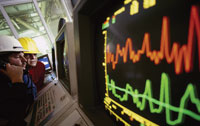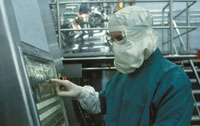A variety of electronic instrumentation is used to monitor flows, pressures, temperatures and other features in chemical plants, in real-time, to ensure that the production processes are working properly and to avoid breakdown of machinery and accidents. As chemical plants in the developed world become older, because of the lack of investment in new capacity, it is even more important to be constantly on the alert for the first signs of failing equipment, which can be costly and stop production.
At a time of rising energy costs, when the price of electricity can change by the hour, realtime monitoring is also an essential means of keeping a tight grip on plant overheads. Such monitoring also provides a way of reducing wastage of raw materials, which are increasingly supplied through quarterly and even monthly deals.
The changing workforce
In recent years, there has been an increase in automation, particularly in the chemical industries of Europe, North America and Japan, because of the growing shortage of qualified staff. As plant operators and engineers retire, they are not being replaced by people of similar knowledge and experience.
'The recession has perhaps postponed the qualified staff crisis by a few years,' says Eddie Habibi, chief executive of PAS, Houston, Texas, a US supplier of automation solutions to the chemical and other process industries. 'Some chemical companies are in danger of losing as much as half of their qualified staff within a few years. Executives are looking to increasing automation to resolve their problems with personnel shortages.'
As instrumentation, rather than people, takes over the task of monitoring much of the Software design. A major objective of software producers in this field is to provide systems that not only alert operators to possible breakdowns and dangerous leaks but also analyse data to discover trends. 'We’re learning from data,' said Tremblay. 'We don’t just use our systems to detect events but to work out risk patterns through analysis of the data. We can then recommend that certain actions be taken by operators.'
'It is like designing an aeroplane while forgetting about the pilot,' he explains. 'In fact, in the aviation industry, a tremendous amount of effort has been put into the design of the interface between the pilot and all the data coming from the aircraft’s equipment. A big challenge for the chemical and other process industries is to deal with the problem of a lack of a proper interface for plant operators so that they can do their jobs properly.'
New data, greater efficiency
Automation also provides an opportunity for generating new data and information about a plant, and thus gives some insight into how it can be run more efficiently.

The application of wireless sensors and controls has more recently increased the collection of data to parts of plants that were previously difficult to monitor. And as new energy-harvesting technologies, which exploit solar, vibrational and mechanical energy, replace batteries, the amount of data coming from wireless equipment could get a further boost.
'Sensors based on energy harvesting are more economical than other wireless systems and more practical because changing batteries in a network of sensors can be a nightmare,' explains Keith Abate, business development director at UK-based Perpetuum, a specialist in technologies for harvesting vibration energy. 'The market for sensors based on energy harvesting should start to take off in the next couple of years once the market has decided what single technical standard should be applied to wireless systems.' A sensor system developed by General Electric and powered by Perpetuum’s technology is currently being tested by a leading petrochemicals and refining company in Europe to see how well it detects early signs of faults in bearings.
Increases in the amount of data available have also come about by improvements in the precision of instrumentation. 'You need precision because without it early detection of faults is not possible,' Gilles Tremblay, president of R2, a monitoring systems supplier, told the recent International Chlorine Technology Conference, organised by EuroChlor in Budapest, Hungary. 'Without precision, you will get false trips and large buffer zones than necessary between safety limits, which can ultimately compromise safety.'
Tremblay gave as an example the high precision equipment now available for detecting voltage fluctuations in electrolysis units used in the manufacture of chlorine. More efficient equipment is revealing process safety and other information about which plant engineers were previously unaware. For example, the introduction of an infrared system for detecting levels of hydrogen in wet chlorine has revealed that hydrogen levels build up in membrane units when they are not operating. If hydrogen rises to 3–4% of a hydrogen–chlorine mixture, it can cause an explosion.
'The old thermal conductivity technology for detecting hydrogen at the start-up was not selective enough,' Chris du Bois, senior vice president technology at AppliTek in Belgium, told the Budapest meeting. 'When we started testing our infrared technology we detected concentrations of hydrogen during start-ups. The plant operators were surprised. They did not know it was happening. Hydrogen was flowing through the membranes because of pressure differences during periods of standstill. It needed to be flushed out before production began.'
Software design
A major objective of software producers in this field is to provide systems that not only alert operators to possible breakdowns and dangerous leaks but also analyse data to discover trends. 'We’re learning from data,' said Tremblay. 'We don’t just use our systems to detect events but to work out risk patterns through analysis of the data. We can then recommend that certain actions be taken by operators.'

Companies like PAS have developed software tools for converting data coming from the monitoring systems in a typical chemical plant into a common data format for storage. The data generated by the complex interaction of different systems are contextualised so a simplified view of a plant and its processes can be preserved. In this way, knowledge of the processes, which can become embedded in automation systems, can be retained so that additions can be made by a wide range of personnel on a site.
'This is a means for systematically capturing knowledge on petrochemical and refining complexes from automation equipment, from IT sources like the Internet and emails, and above all from the minds of employees,' says Habibi. 'An operator might, for example, not know how to deal with an alarm so he asks for advice from an experienced engineer. That advice comes back in the form of an email, which is stored and categorised so that the expert knowledge within it is never lost.'
Growing confidence
Growing confidence in the reliability of automation technologies has been demonstrated by a rise in the numbers of remote-controlled plants in the chemical industry.
Already in the oil and gas sector, offshore rigs are being run by onshore command centres through networks of sophisticated communications and monitoring technologies.
Dutch chemical major AkzoNobel has been expanding its experience of remote-controlled production of chemicals such as hydrogen peroxide to chlorine, the large-scale manufacture of which is a core company competence.
Together with engineering company Uhde and chloralkali technology specialist UhdeNora, AkzoNobel has developed a concept for a remotecontrolled 15,000 t/year chlorine plant. During 2011, the collaboration hopes to clinch its first deal for the construction of the plant, probably in Europe, which is its target market. 'The functionality of the operator in a manned plant is replaced by hardware and software and guidance from a distance,' Ellen Holmen, AkzoNobel’s business manager for remote controlled chlorine production, said at the Budapest conference. 'The design principle is “eyes on, hands off”.'
The company, which will own the plants as well as their output, is setting up a dedicated control room at Bitterfeld, Germany, where it has a large chloralkali facility. 'It is planned that the operators will run and be in charge of up to five remote controlled plants simultaneously,' Holmen said.
The move to remote-controlled production shows how much automation has become not just a solution to personnel shortages but also potentially a means for substantially raising the productivity of chemicals and related process industries.





